Contact us today:

(847) 934-4500
tdaro@bernardandcompany.com

Contact us today:
(847) 934-4500
tdaro@bernardandcompany.com
Brazilian steel giant Usiminas recently introduced the new foundry core making simulation software MAGMASOFT® as part of their strategy to establish robust designs and processes for their core production line. The first project on which this software was utilized was already in progress at that time.
The main goal was to optimize the process conditions for the existing tooling layout. This core, called the thin waist core, represents some of the biggest challenges for Usiminas core production: its length (920 mm), substantial changes in the sand flow direction during blowing, the need to fill certain parts of the core through counter-flow and big variations in the cross section within the core.
First trials showed problems with the process, which led to a complete collapse of the lower part of the core. The core blowing and curing steps for the PU coldbox process were analyzed, making it possible to draw preliminary conclusions regarding the existing defects.
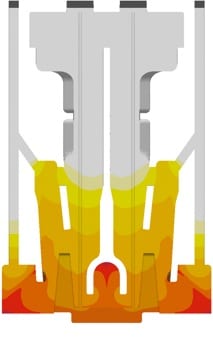
Figure 2. Curing Gas Concentration. The curing gas does not penetrate into the core to the same extent everywhere.
The lack of core strength was related to a poor curing process. The first simulation (Figure 2) already showed that the problematic regions experienced only very low curing gas concentrations during gassing, which was the root cause for the failure.
On the production line, various process conditions such as the curing and purging times and gassing pressure were changed. These attempts provided better results (Figure 3). However, a perfect core could still not be produced. The further analysis with MAGMASOFT® focused on the evaluation of the local concentration of adsorbed curing gas, as it shows the regions where the catalyzing gassing agent cannot activate the chemical reaction. This result clearly demonstrated that only a very small quantity of catalyst was available for accelerating curing in the defect regions (Figure 3).

Figure 3. Core Blown with new parameters in comparison with the local concentration of adsorbed curing gas. The problematic area corresponds exactly with low concentrations in the simulation.
Evaluating simulated curves for the gas mass flow through the vents made it clear that the catalyzing gas was not reaching the critical area. The open venting cross section of the top and central vents was allowing the gas to escape before it reached the bottom of the core.
Instead of making costly modifications to the core box, Usiminas determined that a possible – and simple – solution was to close some vents in the top and center regions, in order to increase the gas concentration in the bottom. However, it was clear that these changes obviously would also influence the core blowing step.
The optimization led to a considerable increase of the curing gas concentration in the lower regions of the core (~36%) (Figure 4). Also, the amount of adsorbed curing gas increased in comparison to the original project. Applying these modifications, Usiminas produced another core, which did not show any gassing defects. Since the venting area was reduced, some filling defects were present, as expected.
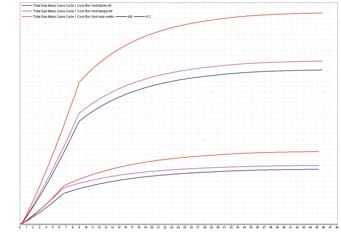
Figure 4. Total gas mass flow through the lower vents. The change in mass flow becomes clear. Removing some of the upper and middle vents resulted in a 36% increase in the gas escaping through the lower vents.
Having solved the curing related defects, a further core blowing analysis was carried out. The simulation results showed a very good match between the real defects and areas of low packing density. The flow animation also showed that the problems occurred because these areas had to be filled by a counter flow of the sand (Figure 5).
Another characteristic of the defects was that they all occurred next to the parting line of the core box. Some of the defects showed a smooth surface, indicating that the sand had been removed by a strong air flow. The core blowing simulation results supported the Usiminas conclusion that an improper sealing of the tool was the root cause for these defects. Air could escape with high speed through the parting lines, resulting in the defect formation.
This hypothesis was tested using a silicone rubber band to obtain an improved sealing of the relevant areas of the tool. With this modification, a new core was produced which was absolutely free of any defects.
About software for casting process simulation
Casting process simulation software considers the complete casting process including mold filling, solidification and cooling, and also provides the quantitative prediction of mechanical properties, thermally induced casting stresses and the distortion of cast components. Simulation accurately describes a cast component’s quality upfront before production starts, thus the casting layout can be designed with respect to the required component properties. This results in a reduction in pre-production sampling, but also the precise layout of the complete casting system leads to energy, material and tooling savings for the foundry.
The range of application of MAGMA solutions comprises all cast alloys, from cast iron to aluminum sand casting, permanent mold and die casting up to large steel castings. The software supports the user in component design, the determination of melting practice and casting methodology through to mold making, heat treatment and finishing. This saves costs consequently along the entire casting manufacturing line.
During the last 10 years, the use of casting process simulation has become a valuable business asset for many foundries worldwide. MAGMA5 constantly expands the capabilities of casting process simulation and will further accelerate the acceptance of this technology, in the future.
About Usiminas
With 50 years of operation, Usiminas is the leader in the Brazilian flat steel market and one of the largest steel companies in Latin America. It has a nominal capacity of 9.5 million tons of steel per year. Usiminas Mecânica is a leading provider of capital goods and services to the steel, railway, mining, automotive, energy, petrochemical, marine and infrastructure industries in Brazil. With recent substantial investments, the foundry of Usiminas Mecânica has become one of the largest manufacturers of both small and large steel castings in the country. The yearly production capacity is 30,000 tons, representing about 10% of the projected production in Brazil.
About MAGMA
MAGMA offers comprehensive solutions to the metal casting industry, casting buyers and casting designers worldwide. The MAGMA product and service portfolio includes the powerful modular simulation software MAGMASOFT®,with the newest release MAGMA5, as well as engineering services for casting design and optimization.
Today, MAGMASOFT® is used throughout the metal casting industry, especially for the optimization of cast components in automotive and heavy industry applications.
MAGMA Giessereitechnologie GmbH was founded in 1988 and is headquartered in Aachen, Germany. A global presence and support are guaranteed by offices and subsidiaries in the USA, Singapore, Brazil, Korea, Turkey, India and China. Additionally, more than 30 qualified partners represent MAGMA around the world.
For more information on this release, please contact:
Christof Heisser
President
MAGMA Foundry Technologies, Inc.
10 N. Martingale Road, Suite 425
Schaumburg, IL 60173
Phone: 847-969-1001 ext. 225
Email: cheisser@magmasoft.com
Web: www.magmasoft.com
Casting process simulation to automotive industry standards
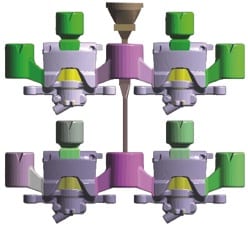 Continental is one of the five biggest international automotive suppliers worldwide. The two group sectors, Automotive and Rubber, provide a range of products addressed to automotive trends in the areas of safety, environment and information. In 2009, the 143,000 employees in six divisions generated sales of approximately 20 billion euros (~$28B).
Continental is one of the five biggest international automotive suppliers worldwide. The two group sectors, Automotive and Rubber, provide a range of products addressed to automotive trends in the areas of safety, environment and information. In 2009, the 143,000 employees in six divisions generated sales of approximately 20 billion euros (~$28B).
Cast components can be found throughout engine, brake system, body and interior components. For this reason, Continental, with its three automotive divisions, is one of the world’s largest consumers of castings. Continental does not produce the castings itself, but instead buys these parts in large quantities from outside vendors. In view of the great importance of these components in its products and systems, the Automotive Group devotes a great deal of attention to its cooperation with foundries. For Continental, it is vital that all suppliers reliably meet their quality standards and can guarantee secure processes. If production lines come to a standstill at Continental – or worse, at Continental’s customers – losses can quickly run into the millions.
As a direct supplier to carmakers, Continental is in a sandwich position. The company must guarantee product and process quality to its customers and pass on these requirements to its own suppliers. Consequently, continuous audits of partners are used to assure a constant, sustainable productivity and to ensure the use of the most competitive technologies. The same applies to requirements for product and service quality, which must be highly cost effective, as well as comply with project deadlines.
Casting simulation as foundry selection criterion
When it comes to the quality of purchased castings, Mustafa Ata, Senior Expert Casting Quality, is in demand in Continental’s Automotive Group. He audits the foundries which supply Continental worldwide. “The quality requirements for castings, which are for the most part installed in safety-relevant areas of cars, are extremely high. The prevailing international standards are supplemented by internal group standards, e.g. with regard to service life, material strength, metallurgical properties (microstructure), machinability of the components and optical appearance,” Mustafa Ata said when describing what he expects from foundries.
From Continental’s point of view, a reliable compliance with this performance catalog cannot be achieved without the foundries using the latest casting technology and tools. In the case of safety components, the group requires its suppliers to use software for casting process simulation, to check the casting process and analyze the results with Continental before production starts. Continental also requires that their foundries be in a position to optimize the process if necessary.
“Simulation is anchored as an important part of supplier communication. This means that in every casting project, product realization is supported from the very beginning by numerical simulation. We expect our suppliers to possess a simulation tool,” Ata noted, leaving no doubt in this regard.
 From design to production – but not without simulation
From design to production – but not without simulation
The casting development process begins at Continental. The design department designs the casting according to the automotive manufacturer’s requirements. The 3D data produced goes to selected foundries to enable the latter to simulate the casting process with suitable software. The simulation checks various factors that are critical for casting quality simultaneously.
First, the simulation can determine whether the casting was designed in a casting-appropriate manner or whether the design department, in cooperation with the suppliers (simultaneous engineering), needs to readjust the design to permit standard-compliant parts to be reliably produced in a cost-effective casting process. Second, the simulation results can reveal whether, under the specific production conditions of the foundry, a stable, economical process can be established or whether changes need to be carried out.
Simulation result: production and delivery security
As its final result, the simulation provides Ata with the certainty that the foundry can reliably produce and deliver a casting that meets the requirements at optimal costs. Without casting process simulation, such security could only be achieved with multiple casting trials and machining, at costs and project times that are no longer competitive in the automotive industry.
Simulation with MAGMASOFT® welcomed
In general terms, Continental allows its suppliers to choose which software they use for casting process simulation. But, most foundries opt for the MAGMASOFT® software from MAGMA Gießereitechnologie GmbH, which Ata welcomes for various reasons.
MAGMA is the pioneer in casting process simulation software. As a software developer, more casting engineers work at MAGMA than in many foundries. Because of this, MAGMA is regarded as the worldwide market and technology leader and sets the standard in this field.
The simulation results provided by MAGMASOFT® are extremely realistic.
Empirical checks through real trial castings regularly demonstrate that the results correspond to a large extent with the observable properties of the cast components.
“Simulation results from MAGMASOFT® are accepted as reliable by all parties involved in the production process. As a result, they form the basis on which designers, foundrymen and users can discuss component quality and process optimization, further developments and modifications,” according to Ata.
MAGMASOFT® offers solutions for all casting processes and process steps. In doing so, the software covers every possible simulation situation which arises at Continental in the cooperation with foundries. Therefore, the partners do not need to deal with different applications.
In the foundry, MAGMASOFT® users benefit from the simple operation of the software and the service of the provider, which meet the high demands of the automotive industry.
Continental considering using MAGMASOFT® itself
Until now, Continental has only required that its vendors utilize casting process simulation software. However, Continental is now considering using MAGMASOFT® itself. In this way, the design of a component could be checked for casting suitability immediately and the feedback loops shortened further. Simultaneously, communication with Continental’s development partners could be improved even more through the common “language” of simulation results.
About software for casting process simulation
Casting process simulation software considers the complete casting process including mold filling, solidification and cooling, and also provides the quantitative prediction of mechanical properties, thermally induced casting stresses and the distortion of cast components. Simulation accurately describes a cast component’s quality upfront before production starts, thus the casting layout can be designed with respect to the required component properties. This results in a reduction in pre-production sampling, but also the precise layout of the complete casting system leads to energy, material and tooling savings for the foundry.
The range of application of MAGMA solutions comprises all cast alloys, from cast iron to aluminum sand casting, permanent mold and die casting up to large steel castings. The software supports the user in component design, the determination of melting practice and casting methodology through to mold making, heat treatment and finishing. This saves costs consequently along the entire casting manufacturing line.
During the last 10 years, the use of casting process simulation has become a valuable business asset for many foundries. MAGMA5 now expands the capabilities of casting process simulation and will further accelerate the acceptance of this technology.
About MAGMA
MAGMA offers comprehensive solutions to the metal casting industry, casting buyers and casting designers worldwide. The MAGMA product and service portfolio includes the powerful modular simulation software MAGMASOFT®,with the newest release MAGMA5, as well as engineering services for casting design and optimization.
Today, MAGMASOFT® is used throughout the metal casting industry, especially for the optimization of cast components in automotive and heavy industry applications.
MAGMA Giessereitechnologie GmbH was founded in 1988 and is headquartered in Aachen, Germany. A global presence and support are guaranteed by offices and subsidiaries in the USA, Singapore, Brazil, Korea, Turkey, India and China. Additionally, more than 30 qualified partners represent MAGMA around the world.
For more information on this release, please contact:
Christof Heisser
President
MAGMA Foundry Technologies, Inc.
10 N. Martingale Road, Suite 425
Schaumburg, IL 60173
Phone 847-969-1001 ext. 225
Email cheisser@magmasoft.com
Agency contact:
Wendy McCormick
Bernard & Company
847-934-4500
Continue readingSchaumburg, IL –Removing Roadblocks to Success was the theme for the 2011 MAGMASOFTNorth American User Group meeting, held September 13-15, 2011 at Eaglewood Resort & Spa in Itasca, Illinois. One of the main purposes of the annual MAGMASOFTUser Group Meeting (UGM) is for MAGMA to provide its users with ways to be more successful using MAGMASOFT, the leading simulation software in the foundry market. MAGMA has learned that their users benefit greatly by gaining knowledge from each other as well as relying on the MAGMA engineers for technical support.
MAGMA looks to its customers to help them continue to improve and grow as an organization. MAGMA sees itself as an asset to their customers’ entire organization and wants to help them to not only utilize MAGMASOFT to its fullest potential, but to go beyond the engineering department and implement MAGMASOFT in their entire organization, i.e. in sales and marketing, production, and quality departments. The more areas in the customer’s organization where MAGMASOFTis utilized, the more productive and profitable their operations become, according to company president Christof Heisser.
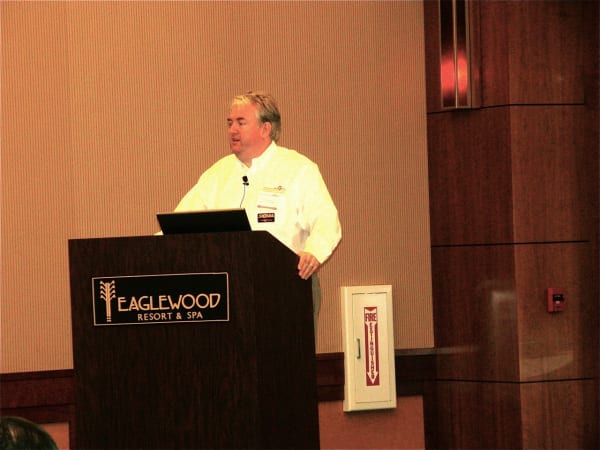
Christof Heisser, President of MAGMA Foundry Technologies, Inc. welcomes the MAGMASOFT users to the 2011 North American User Group Meeting.
MAGMASOFT users addressed the group with their presentations. Greg Miskinis from Thyssen Krupp Waupaca presented “How To Get Management to Write the Big Check.” Keith Pearl from Caterpillar South Milwaukee discussed “Utilizing MAGMASOFTin the Supply Chain.” Brodie Biersner and Sairam Ravi, both from the University of Northern Iowa, presented papers on mold instrumentation and simulation of veining defects using MAGMAapi, respectively. Lastly, Charlie Monroe from Caterpillar closed out the general session with his presentation entitled “Save Money Using MAGMAfrontier.”
In addition, three candidates, Ivy Courtney from Riverside Brass, Jason Lythjohan from Premier Aluminum and Ian McNally from Hodge Foundry gave their presentations for their MAGMASOFTCertification within the MAGMA User Group.
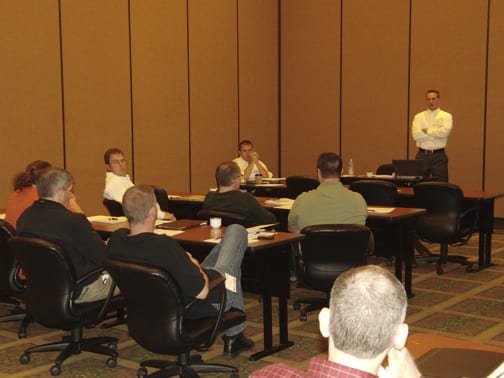
Steve Sikorski and Benji Johnson (seated at front table) both from MAGMA facilitate the non-ferrous breakout group discussion on “roadblocks”
After completing a questionnaire regarding different roadblocks during the general session, the 120 MAGMA users in attendance were split into one of four categories: HPDC, Non-ferrous, Steel or Iron. In these groups, potential roadblocks such as set-up and analysis of simulation, calculation times, hardware (memory, speed), capability (training) of users, immediate management, upper management, workload, communication issues with customers, as well as others were discussed in a peer-to-peer group setting, with attendees as well as MAGMA staffers providing possible solutions.
The advanced use of MAGMASOFTand specifically its latest version MAGMA5was a recurring topic in the traditional small group breakout sessions. In addition, guest speakers presented process and alloy specific topics, creating an environment for interaction between these technical experts, users and MAGMA staff. To close the two-day meeting, details of the anticipated version 5.2 and future developments were presented to the User Group.
For more information on this release, please contact: Christof Heisser President MAGMA Foundry Technologies, Inc. 10 N. Martingale Road, Suite 425 Schaumburg, IL 60173
Phone 847-969-1001 ext. 225 Email cheisser@magmasoft.com Web www.magmasoft.com
Agency contact: Wendy McCormick Bernard & Company 847-934-4500 wendy@bernardandcompany.com
Continue reading
Wisconsin foundry prospering from its use of technology, including MAGMASOFT® simulation software for metalcasting
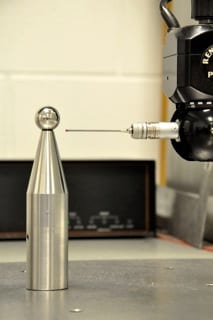 Schaumburg, IL – Premier Aluminum is an ISO 9001-2008 certified permanent mold aluminum casting and machine shop in Racine, Wisconsin with a reputation for partnering with its customers to find flexible and cost-effective solutions for a variety of products. The company serves the quantity casting market, from a few hundred castings per year to annual volumes of fifty thousand and more. Premier positions its capability in the market as a one-stop shop for finished machined, permanent mold aluminum castings.
Schaumburg, IL – Premier Aluminum is an ISO 9001-2008 certified permanent mold aluminum casting and machine shop in Racine, Wisconsin with a reputation for partnering with its customers to find flexible and cost-effective solutions for a variety of products. The company serves the quantity casting market, from a few hundred castings per year to annual volumes of fifty thousand and more. Premier positions its capability in the market as a one-stop shop for finished machined, permanent mold aluminum castings.
Premier has invested in all necessary tools and facilities to enable full collaborative engineering with its customers. Its current goal is to achieve the desired casting quality by further reducing costs and decreasing time to market for its customers. This progressive approach to working with customers by utilizing advanced technical tools in an R&D facility will now be referenced as the Technology Center at Premier Aluminum.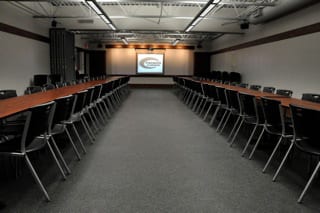
The Technology Center will now be available to any Premier customer or potential customer who wishes to work closely with the Premier Engineering Team to quickly and accurately develop new products or re-engineer already existing ones. Its engineering team boasts 50+ years experience in metalcasting, plus the latest advancements in the aluminum foundry industry. To better serve its customers, Premier employs such advanced software as Solidworks, MAGMASOFT® and other engineering tools to enhance customer confidence in tool life, product quality and efficient manufacturing processes, through a more predictive and trackable engineering protocol.
 One of the company’s most effective engineering tools is MAGMASOFT®, provided by MAGMA Foundry Technologies, which is a software used to assist engineers, designers and buyers in the metalcasting industry. Premier’s engineering group utilizes MAGMASOFT® to optimize the casting design as well as to refine the casting process from the outset. MAGMASOFT® blends science, technology and experience from diverse areas of the casting process to create a package that utilizes the complex physics of casting to simulate the results prior to creating the mold. This technology-based strategy, combined with years of experience serving the global foundry market, allows Premier to optimize its designs for castability, quality and overall lowest cost.
One of the company’s most effective engineering tools is MAGMASOFT®, provided by MAGMA Foundry Technologies, which is a software used to assist engineers, designers and buyers in the metalcasting industry. Premier’s engineering group utilizes MAGMASOFT® to optimize the casting design as well as to refine the casting process from the outset. MAGMASOFT® blends science, technology and experience from diverse areas of the casting process to create a package that utilizes the complex physics of casting to simulate the results prior to creating the mold. This technology-based strategy, combined with years of experience serving the global foundry market, allows Premier to optimize its designs for castability, quality and overall lowest cost.
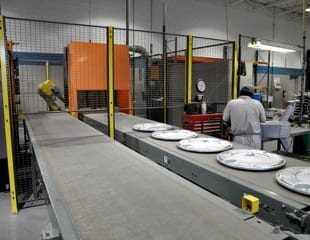 In today’s environment, Premier is seeking all possible ways to be competitive and work together to find solutions that ultimately benefit the entire supply chain. Supply chain efficiency reduces time to market and engineering costs, emphasizes collaboration and yields sound manufacturing processes that will increase customer competitiveness. The company is committed to this technology-driven approach and seeks the opportunity to share it with current customers and prospects alike.
In today’s environment, Premier is seeking all possible ways to be competitive and work together to find solutions that ultimately benefit the entire supply chain. Supply chain efficiency reduces time to market and engineering costs, emphasizes collaboration and yields sound manufacturing processes that will increase customer competitiveness. The company is committed to this technology-driven approach and seeks the opportunity to share it with current customers and prospects alike.
 Premier’s sales manager, Kevin Kelly, is currently inviting customers and prospects to send their product experts to the Technology Center for an opportunity to collaborate with the company’s engineers on any new products or existing designs. During the visit, customer or prospect teams will be able to access the Internet, collaborate face-to-face with Premier’s engineering staff, gain knowledge of the aluminum casting processes and utilize any of the technology tools, especially MAGMASOFT®, to bring their product to market faster, more efficiently and at a lower overall cost.
Premier’s sales manager, Kevin Kelly, is currently inviting customers and prospects to send their product experts to the Technology Center for an opportunity to collaborate with the company’s engineers on any new products or existing designs. During the visit, customer or prospect teams will be able to access the Internet, collaborate face-to-face with Premier’s engineering staff, gain knowledge of the aluminum casting processes and utilize any of the technology tools, especially MAGMASOFT®, to bring their product to market faster, more efficiently and at a lower overall cost.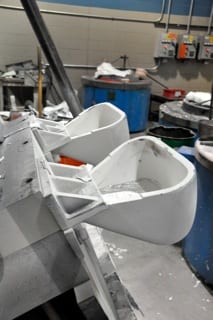
For more information on this announcement, please contact:
Kevin Kelly – Sales Manager PREMIER ALUMINUM 3633 S. Memorial Dr. Racine, WI 53403 Phone: 262-554-2100, Ext. 130 Email: kevin.kelly@premieraluminum.com Web: www.premieraluminum.com
OR
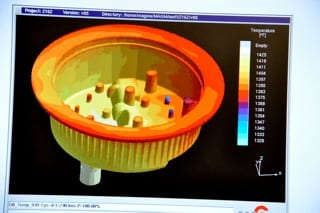 Steve Sikorski – Vice President of Applications & Technology MAGMA Foundry Technologies, Inc.
Steve Sikorski – Vice President of Applications & Technology MAGMA Foundry Technologies, Inc.
10 N. Martingale Road, Suite 425 Schaumburg, IL 60173 Phone 847-969-1001, ext. 223
Email: ssikorski@magmasoft.com Web:www.magmasoft.com
Agency contact: Tim Daro Bernard & Company 847-934-4500 tdaro@bernardandcompany.com
Continue reading Fred Phillips, Regional Manager of SIGMA Plastic Services, Inc. will be giving a seminar on “The Next Generation of Injection Molding” at the June 30th SPE GGS lunch.
Fred Phillips, Regional Manager of SIGMA Plastic Services, Inc. will be giving a seminar on “The Next Generation of Injection Molding” at the June 30th SPE GGS lunch.
In-depth injection molding simulation software has typically been used by analysts who have the expertise to setup the complex mesh model required for simulation. With advanced simulation technology from SIGMA, injection molding simulation is easier to use and more accurate than ever. This opens the door to product designers, project managers, and engineers in charge of polymer injection molds and processes, as well as analysis groups. Companies no longer need to rely on a “meshing expert” to employ injection molding simulation.
The presentation will highlight the power of injection molding simulation when considering 3D mold components, cooling channels, the complete runner system, and part geometries coupled with multi-cycle analysis. Simulation is a must-have tool for companies wanting to evaluate ‘what if’ scenarios of the entire injection molding process early in the design and tooling stages.
Where: Exponent, Inc. 149 Commonwelath Drive, Menlo Park, CA
When: Thursday, June 30, 2011, 11:30 AM – 1:00 PM (lunch provided to those attending the seminar)
Cost: Lunch: $20 non-members, $15 members, $10 students/unemployed/retired – cash at door or via Paypal
Cost: Webinar: $10 – Paypal only. WebEx invitation will be sent upon receipt of payment
RSVP: Jennifer Hoffman at jhoffman@exponent.com; RSVP by noon, Tuesday, June 28th.
During the upcoming GIFA 2011 show in Dusseldorf, Germany, Magma will present its new software generation for casting process simulation, MAGMA5. At the 300 sq. m stand 12A16, the company will demonstrate how casting process simulation with MAGMA5 can be used for optimization at all stages of casting manufacturing to contribute to foundry profitability. MAGMA will show the newest version MAGMA5 5.2 with extended capabilities for all cast materials and processes, introduce its new software MAGMA C+M for the simulation of the core production processes and provide a view into the future of autonomous optimization of casting processes. Additionally, MAGMA is participating in the initiative “ecoMetals” from the Messe Düsseldorf, which supports companies who develop innovative products and processes leading to a more efficient use of energy. MAGMA will demonstrate, using practical examples, how the application of casting process simulation considerably increases a foundry’s energy and resource efficiency.
MAGMA5 – optimized simulation

Autonomous optimization of casting processes and layouts, shown here for gating optimization in die casting, is the future of casting processsimulation.
MAGMA5 5.2 introduces several new simulation capabilities: new process modes for permanent mold, low pressure sand and low pressure die casting, as well both hot-chamber and cold-chamber die casting, allow for detailed process-specific definitions. The software also supports process design by controlling process parameters during a simulation run. For gravity casters, process modules for DISAMATIC and investment casting are now available.
At GIFA, MAGMA will also present its newest developments for the quantitative prediction of as-cast and heat treated local microstructures and properties in aluminum, iron and steel castings. MAGMA5 simulates sand and reoxidation inclusions during mold filling and predicts defects related to molding materials. MAGMAnonferrous calculates the final microstructure and mechanical properties for aluminum alloys considering the metallurgy, inoculation, and hydrogen content of the melt. MAGMAiron predicts local microstructures for iron materials from graphite growth through to the distribution of phases making up the matrix. MAGMAsteel calculates macrosegregation in steel castings and the local microstructure resulting from heat treatment.
The stress module MAGMAstress for the first time offers casters the option to calculate thermally induced casting stresses in permanent molds for all manufacturing steps, including heat treatment and finishing, in order to predict casting crack problems and distortion. The simulated distortion results can be evaluated just as on a coordinate measuring machine and compared directly with real measurements. For the first time, the new module MAGMAdielife facilitates the evaluation of the effects of tooling design and thermal stresses on the durability of permanent molds.
MAGMA Core+Mold – transparency in core production
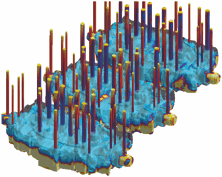
With MAGMA C+M, the simulation of the core shooting process is possible for complex tools, shown here for three cores including blow tubes in a single core box.
With MAGMA C+M, MAGMA introduces an integrated tool for the simulation of core production processes. MAGMA C+M simulates core shooting, blowing and hardening of organic and inorganic cores. Processes where binder hardening is driven by a catalyst gas as well
as core production with tempered core boxes are supported. MAGMA C+M considers all aspects of core production starting from the core shooter, in order to calculate the flow of the air-sand mixture based on the real shot parameters. An integrated database provides the ability to specify the characteristics of the sand and the binder system as well as core box vents and blow tubes. The program simulates gassing, purging and the curing reaction of gas-hardened cores. The design and control of core box tempering for heat-cured cores (hotbox, croning, inorganic) is effectively supported by modeling of heating cartridges and oil channels. For inorganic cores, MAGMA C+M calculates the drying of the core in the heated core box as well as due to transport of water vapor by hot air during gassing. MAGMA C+M takes advantage of all the functionality of MAGMA5 and is available as an add-on module to MAGMA5 or asa stand-alone product.
Autonomous optimization is the future
With autonomous optimization, foundrymen can make use of simulation in order to pursue their objectives for quality and cost. Autonomous optimization makes proposals for the right casting layout or the optimum process parameters. The virtual test foundry in the computer enables variation of parameters and systematic examination of influencing variables leading up to the optimum configuration. Based on the fundamental physics embedded in MAGMA5, the program finds the best possible dimensions and positions of ingates, as well as the location of feeders and chills including their optimum size. Using industrial examples, MAGMA will present state-of-the-art capabilities and provide a view into the future of optimization.
MAGMA – very involved
At the accompanying WFO Technical Forum, MAGMA will give presentations on the topics of aluminum casting, core production, and optimization. At the NewCast exhibition, which takes place in parallel with GIFA, simulation specialists will discuss the prediction of residual stresses and distortion in cast iron components.
MAGMA also has a further exhibition stand (12A15) as part of the “Get-In-Form” project “Youth-Technology-Future” (“Jugend-Technik-Zukunft“). Here, the attractiveness of work as a professional or specialist in the metal casting industry will be illustrated to students and apprentices in an entertaining and interactive manner.
About software for casting process simulation
Casting process simulation software considers the complete casting process including mold filling, solidification and cooling, and also provides the quantitative prediction of mechanical properties, thermally induced casting stresses and the distortion of cast components. Simulation accurately describes a cast component’s quality upfront before production starts, thus the casting layout can be designed with respect to the required component properties. This results in a reduction in pre-production sampling, but also the precise layout of the complete casting system leads to energy, material and tooling savings for the foundry.
The range of application of MAGMA solutions comprises all cast alloys, from cast iron to aluminum sand casting, permanent mold and die casting up to large steel castings. The software supports the user in component design, the determination of melting practice and casting methodology through to mold making, heat treatment and finishing. This saves costs consequently along the entire casting manufacturing line.
During the last 10 years, the use of casting process simulation has become a valuable business asset for many foundries. MAGMA5 now expands the capabilities of casting process simulation and will further accelerate the acceptance of this technology.
About MAGMA
MAGMA offers comprehensive solutions to the metal casting industry, casting buyers and casting designers worldwide. The MAGMA product and service portfolio includes the powerful modular simulation software MAGMASOFT®,with the newest release MAGMA5, as well as engineering services for casting design and optimization.
Today, MAGMASOFT® is used throughout the metal casting industry, especially for the optimization of cast components in automotive and heavy industry applications.
MAGMA Giessereitechnologie GmbH was founded in 1988 and is headquartered in Aachen, Germany. A global presence and support are guaranteed by offices and subsidiaries in the USA, Singapore, Brazil, Korea, Turkey, India and China. Additionally, more than 30 qualified partners represent MAGMA around the world.
For more information on this release, please contact:
Christof Heisser President MAGMA Foundry Technologies, Inc. 10 N. Martingale Road, Suite 425 Schaumburg, IL 60173 Phone 847-969-1001 ext. 225
Email: cheisser@magmasoft.com Web: www.magmasoft.com
Agency contact: Tim Daro Bernard & Company 847-934-4500 tdaro@bernardandcompany.com
Continue reading